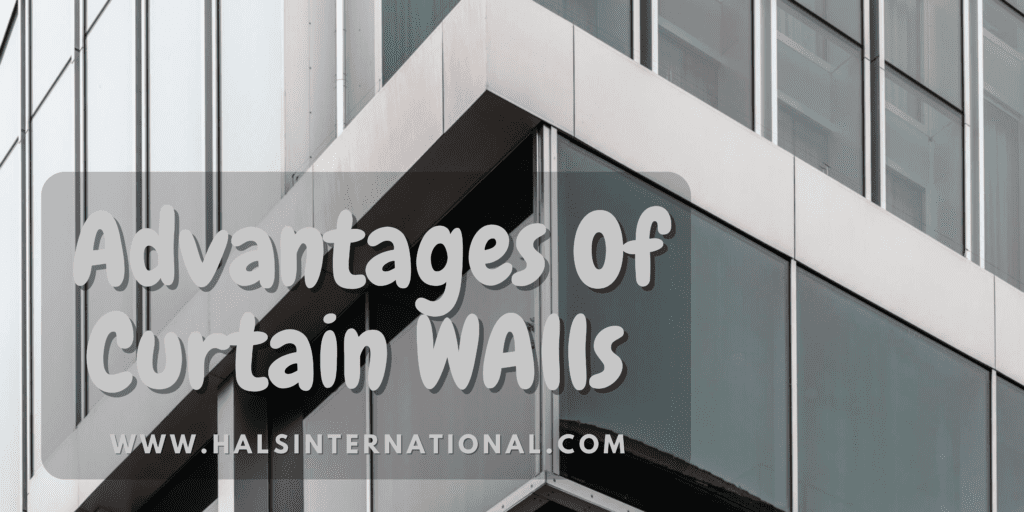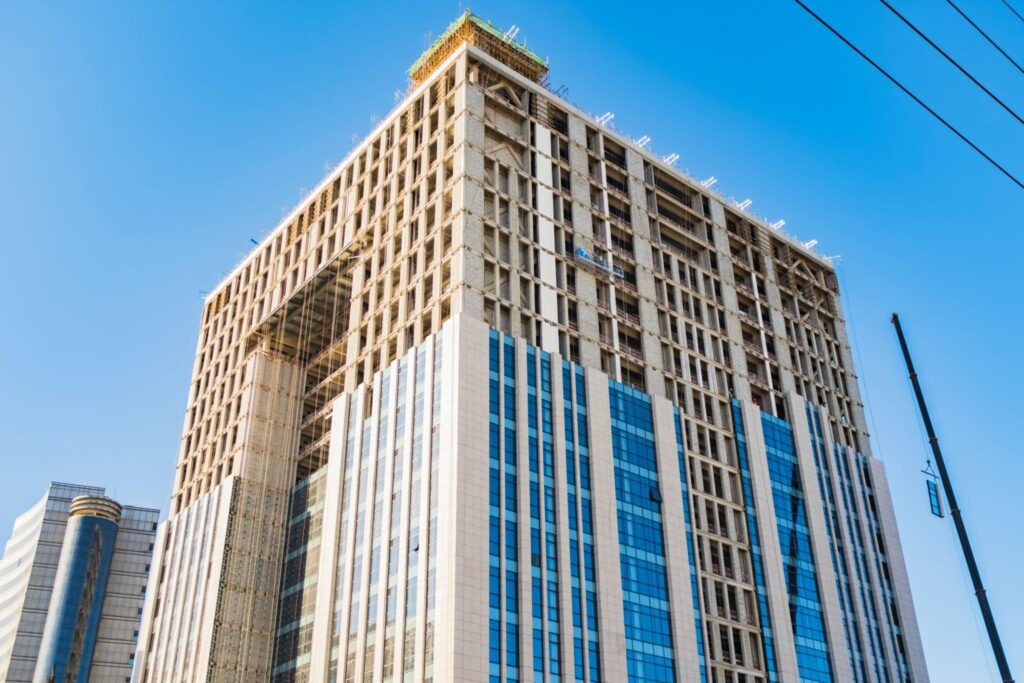
Table of Contents
In modern architecture, curtain walls have revolutionized the way we construct buildings. In addition to enhancing the appearance of a building, these non-structural exteriors offer several benefits as well. They are typically made of lightweight materials, such as glass. Enhancing the overall appearance of a building to improve energy efficiency and sustainability. In this article, we will delve into the advantages of curtain walls and introduce you to Halsinternational, the best choice for top-quality glass fitting services and glass manufacturing.
Enhanced Aesthetics and Design Flexibility
One of the primary advantages of curtain walls is their ability to enhance the aesthetics of a building. With a vast array of materials, finishes, and designs available, curtain walls offer unparalleled design flexibility. Architects can create visually stunning structures that incorporate unique shapes, patterns, and colors, allowing for creative expression and making a bold architectural statement.
Here are our high quality products that you can easily get:
Contact Us For Unique Products And Services
Curtain walls play a crucial role in improving a building’s energy efficiency and sustainability. The integration of advanced insulation materials and thermal breaks helps minimize heat transfer between the interior and exterior, reducing reliance on heating and cooling systems. By providing excellent thermal insulation, curtain walls contribute to energy savings, lower greenhouse gas emissions, and improved indoor comfort.
Natural Light And Daylighting
Another significant advantage of curtain walls is their ability to maximize the use of natural light. The large glass panels allow ample daylight to penetrate the building’s interior, reducing the need for artificial lighting during the day. Natural light has been linked to improved productivity, enhanced mood, and better overall well-being. By facilitating daylighting, curtain walls create a more pleasant and healthier indoor environment.
Sound Insulation And Acoustic Performance
Curtain walls also offer excellent sound insulation and acoustic performance. The combination of multiple glass layers and insulated frames helps reduce external noise, providing a peaceful and quiet interior environment. This advantage is particularly crucial for buildings located in noisy urban areas or near transportation hubs.
Weather Resistance And Durability
With advancements in technology and material science, curtain walls have become highly weather-resistant and durable. They are designed to withstand various environmental conditions, including wind, rain, snow, and extreme temperatures. The tight seals and weather-stripping ensure that the building remains protected from water infiltration, air leakage, and thermal bridging.
Improved Indoor Air Quality
Curtain walls can contribute to improved indoor air quality by incorporating ventilation systems. The use of operable windows or vents in curtain wall systems allows fresh air to circulate throughout the building, reducing the reliance on mechanical ventilation. This natural ventilation helps remove pollutants and maintain a healthy indoor environment.

Advantages Of Curtain Walls
During the last decade, curtain walls have become an integral part of modern architectural design and construction. At the forefront of this architectural innovation, Halsinternational offers top-quality glass fitting services and glass manufacturing, facilitating the realization of cutting-edge designs. Curtain walls, whether made from glass, metal, or stone, provide a range of benefits that extend beyond their aesthetic appeal. Here we mention some advantages of curtain walls
Enhanced Structural Stability
While curtain walls are not designed to provide structural stability on their own, they play a crucial role in enhancing a building’s overall stability. By distributing kinetic forces across the entire frame and structure, they reduce the sway of the building. This, in turn, contributes to a more secure and resilient structure, especially when facing challenging conditions such as high winds. The reduction in building sway also enhances the comfort of building inhabitants.
Easy Maintenance And Accessibility
Maintaining curtain walls is relatively straightforward, thanks to their modular design. Individual glass panels or spandrels can be easily replaced if damaged or discolored, without affecting the entire system. Moreover, access to the exterior of the building for cleaning and maintenance purposes is simplified with the use of external platforms or building maintenance units.
Cost-Effectiveness And Time Efficiency
Despite their high initial costs, curtain walls can provide long-term cost savings. The energy efficiency and durability of curtain walls result in reduced operating expenses, such as lower energy bills and decreased maintenance and repair costs. Additionally, the prefabricated nature of curtain wall systems allows for faster construction, saving time and reducing labor costs.
Customization And Adaptability
Curtain walls offer a high degree of customization and adaptability to meet the specific design and functional requirements of a building. Architects and designers can choose from a wide range of materials, including glass, aluminum, stainless steel, and composite panels, to achieve the desired performance and appearance. Curtain walls can be tailored to suit different architectural styles and accommodate various building conditions.
Improved Thermal Efficiency
Curtain walls, when treated and glazed appropriately, significantly enhance a building’s thermal efficiency. These walls function as an additional layer of insulation, effectively stabilizing the internal temperature. As a result, buildings with curtain walls experience reduced heating and cooling costs, making them more energy-efficient and environmentally friendly. In addition, curtain walls can prevent premature fading or degradation of items within the building thanks to their glazing, which minimizes the entrance of harmful UV light.
Increased Property Value
The addition of curtain walls to a building can significantly enhance its market value. The striking visual appeal and modern design of curtain walls often attract potential buyers or tenants. Buildings with well-designed curtain walls can command higher rents, increase occupancy rates, and contribute to a positive brand image.
Safety And Security
Curtain walls are designed with safety and security in mind. The use of laminated glass or tempered glass with interlayers enhances the structural integrity and provides resistance against break-ins, vandalism, and severe weather events. Additionally, curtain walls can be integrated with advanced access control systems and surveillance technologies to further enhance the building’s security measures.
Fire Resistance
The curtain wall acts as a formidable barrier to slowing the spread of flames between floors in the unfortunate event of a fire. Fire resistance is an important safety feature, particularly in taller buildings where the rapid upward spread of fire can be catastrophic. By impeding fire’s progress, curtain walls provide valuable time for evacuation and emergency response. This additional layer of protection enhances the overall safety of building occupants.
Reduced Environmental Impact
Curtain walls contribute to reducing the environmental impact of buildings. By improving energy efficiency, curtain walls help conserve natural resources and reduce greenhouse gas emissions. Additionally, the use of sustainable materials, such as recycled glass and aluminum, further enhances the eco-friendliness of curtain wall systems.
Versatile Applications
Curtain walls find applications in a wide range of buildings, including commercial offices, retail centers, hotels, educational institutions, and healthcare facilities. Their versatility allows architects to incorporate curtain walls into both new construction projects and renovation or retrofitting projects.
Collaboration and Integration
The design and installation of curtain walls require close collaboration and coordination among architects, engineers, contractors, and manufacturers. Curtain walls need to seamlessly integrate with other building systems, such as HVAC, electrical, and structural components. Effective collaboration ensures that the curtain wall system performs optimally and meets all design, performance, and safety requirements.
Conclusion
Ultimately, curtain walls aren’t just decorative elements in modern architecture; they offer numerous functions that increase a building’s efficiency and sustainability. By incorporating curtain walls into contemporary designs, buildings become safer, more comfortable, and more energy efficient, offering weather resistance, structural stability, fire resistance, and thermal efficiency. Halsinternational’s commitment to top-quality glass fitting and glass manufacturing further ensures that these advantages are realized to their fullest potential, setting the stage for the future of architectural innovation.
For more information and to get the best service, contact us. Our curtain wall systems offer many advantages, and HalsInternational can bring your architectural vision to life.
Frequently Asked Questions
Curtain walls are suitable for various types of buildings, including commercial offices, retail centers, hotels, educational institutions, and healthcare facilities. They can be adapted to meet the specific design requirements of different structures.
Yes, curtain walls can be retrofitted on existing structures, allowing for the transformation of older buildings and upgrading their aesthetic appeal, energy efficiency, and functionality.
Curtain walls enhance energy efficiency by providing excellent thermal insulation, reducing heat transfer between the interior and exterior. This reduces the reliance on heating and cooling systems and results in energy savings.
Regular cleaning and inspection of curtain walls are essential to maintain their appearance and functionality. Damaged or discolored glass panels can be replaced, and the overall system should be checked for any signs of water infiltration or air leakage.
Proper design, installation, and maintenance are crucial to ensure the water-tightness of curtain walls. The use of appropriate sealants, weather-stripping, and flashing details helps prevent water leakage and ensures the long-term performance of the system.
